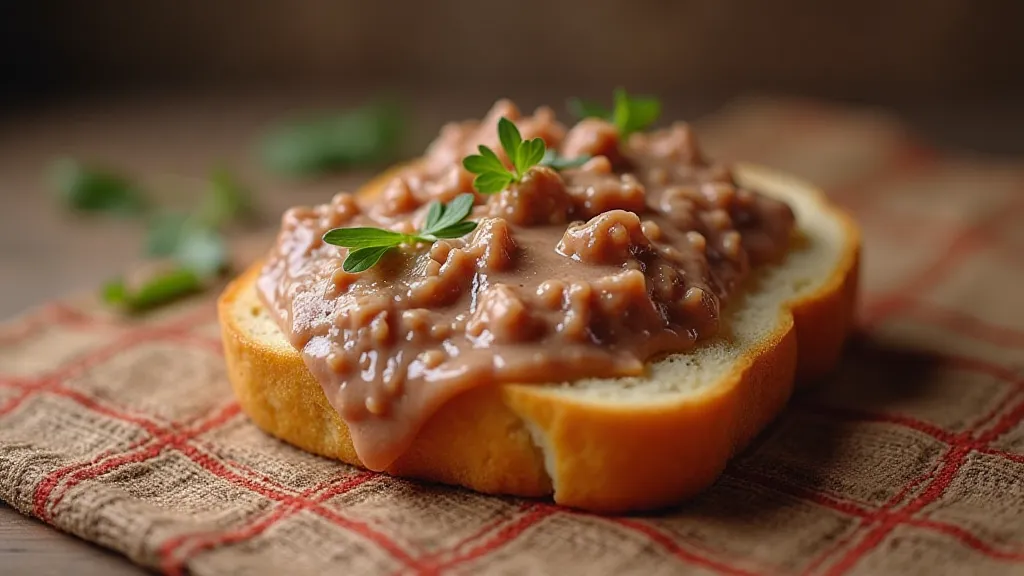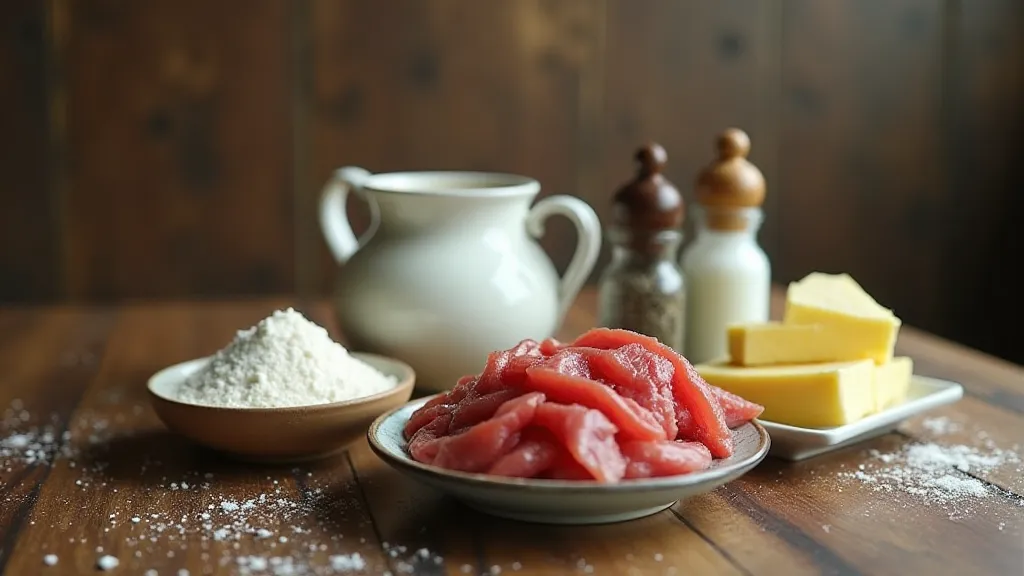Creamed Chipped Beef: A Surprisingly Savory Depression Meal
The Great Depression demanded ingenuity. Families stretched every dollar and every scrap of food, creating meals that were both filling and affordable. Among the surprisingly popular dishes of this era was Creamed Chipped Beef, often nicknamed "SOS" (for "Stuff on Toast"). It might sound unusual today, but it was a testament to the resourcefulness of Depression-era cooks. The resourcefulness born of necessity also extended to how families treated leftovers, often transforming what might have been discarded into something new and sustaining – a kind of culinary alchemy, as exemplified in recipes like “The Alchemy of Leftovers: Transmuting Loss into Sustenance.”
The name "SOS" is believed to have originated in the military, particularly among sailors and soldiers. It was a quick, easy, and relatively inexpensive meal that could be prepared with readily available ingredients. While it wasn’t exclusively a Depression-era dish, the economic hardship of the 1930s cemented its place as a budget-friendly staple for families across America. The simplicity of the dish allowed cooks to adapt it based on what they had on hand, further adding to its appeal. This resourcefulness permeated all aspects of Depression-era cooking, from savory main courses to comforting desserts; imagine the longing for something sweet, and how resourceful cooks might have adapted what little they had to create something akin to a Mock Apple Pie.

Chipped beef, also known as dried beef or thinly sliced dried beef, was a relatively inexpensive source of protein. Drying meat was a traditional preservation method, allowing families to store it for longer periods without refrigeration – a crucial factor during a time when refrigerators were a luxury. The process itself was vital for extending the life of meat, a common necessity given limited resources. And while chipped beef provided a necessary source of protein, families often supplemented their meals with other affordable options, like hearty and filling bean soup, a common dinner staple. The need to stretch every ingredient was a constant challenge, and finding ways to quickly assemble a satisfying meal, even something as simple as a Sloppy Joe, became a testament to the era's resourcefulness – a quick and easy option reflected in recipes like “Sloppy Joes: A Quick and Easy Depression-Era Staple.”
The beauty of Creamed Chipped Beef lies in its minimal ingredients: chipped beef, flour, milk (or sometimes water), butter (or shortening, or lard), salt, and pepper. During the Depression, these were common pantry items, even for families struggling financially. Milk, while sometimes scarce, was a valuable source of nutrition. The ability to substitute water for milk (though the flavor would be less rich) underscored the flexibility required for Depression cooking. Sometimes, even a simple treat like Peanut Butter Cookies, made from limited ingredients, would provide a much-needed boost to morale. The challenge lay not just in acquiring these ingredients, but in creatively incorporating them into meals that would nourish and sustain a family facing hardship.
Here’s a classic recipe, adapted for modern kitchens but retaining the spirit of its Depression-era origins:

Like many Depression-era recipes, Creamed Chipped Beef was often adapted based on what was available. Some cooks added onions or other vegetables to the gravy for extra flavor and nutrition. Others used what they could find as a thickening agent, experimenting with potato starch or even a small amount of mashed potatoes. The scarcity of ingredients fostered a culture of innovation and resourcefulness in the kitchen. Understanding the broader context of the era, the environmental and social conditions that shaped people’s lives, allows us to appreciate the ingenuity displayed in dishes like this one. The need to stretch limited resources often meant improvising, which extended to how families planned and prepared their meals, finding ways to creatively repurpose leftovers and minimize waste. It's a mindset that echoes the core principles behind maximizing resources, a topic explored further in “The Alchemy of Leftovers: Transmuting Loss into Sustenance.”
The Great Depression wasn't just about economic hardship; it was a time of immense psychological strain. Small comforts and simple pleasures took on a profound importance. The aroma of a simmering pot of Creamed Chipped Beef could offer a brief respite from worry and a reminder of home and family. The care taken to prepare even the simplest meal was a form of self-care and a testament to the enduring human spirit. This attention to detail, even in the face of adversity, demonstrates the resilience and strength of the generation that lived through the Depression. Even seemingly insignificant choices, like selecting ingredients or perfecting a cooking technique, became acts of defiance against the pervasive sense of loss and uncertainty. The ease and familiarity of a dish like Creamed Chipped Beef offered a comforting sense of normalcy in a world drastically altered by economic turmoil.
Creamed Chipped Beef may not be a gourmet dish, but it represents a significant piece of American history. It’s a reminder of the ingenuity and resilience of families who faced extraordinary challenges and found ways to nourish themselves with limited resources. Give it a try – you might be surprised at how delicious this simple, historical meal can be! The entire approach to eating during the era emphasized making the most of what was available, highlighting the resourcefulness and adaptability required for survival. Furthermore, the resourcefulness displayed by families extended beyond the kitchen; it permeated every aspect of their lives, as they navigated the challenges of poverty and uncertainty. This adaptive nature aligns with the resourcefulness showcased in simple, quick dishes like “Sloppy Joes: A Quick and Easy Depression-Era Staple,” which were essential for families facing time and budget constraints.

To truly understand the context and significance of Creamed Chipped Beef, it's valuable to delve deeper into the social and economic realities of the Great Depression. The challenges faced by families, the innovations in agriculture and food preservation, and the overall impact on American culture provide a rich tapestry of stories and lessons. Consider researching the impact of the Dust Bowl on food production or exploring the role of government programs in providing relief to struggling families. The details surrounding the era paint a compelling picture of a nation facing adversity, united by a spirit of perseverance and ingenuity. Understanding these challenges highlights the importance of resourceful meal planning, often involving clever substitutions and inventive cooking techniques—a necessity that fueled creativity and resourcefulness in the kitchen.
While the Great Depression is a distant memory for many, its legacy continues to shape American cooking. The emphasis on frugality, resourcefulness, and making the most of what's available remains relevant in today's world, where sustainability and mindful consumption are increasingly valued. Dishes like Creamed Chipped Beef, born out of necessity, offer a tangible connection to the past and a reminder of the resilience of the human spirit. The creativity and innovation displayed by Depression-era cooks—adaptively utilizing every scrap of food—echoes the principles behind reducing waste and maximizing resources, principles embodied in articles like “The Alchemy of Leftovers: Transmuting Loss into Sustenance.”





